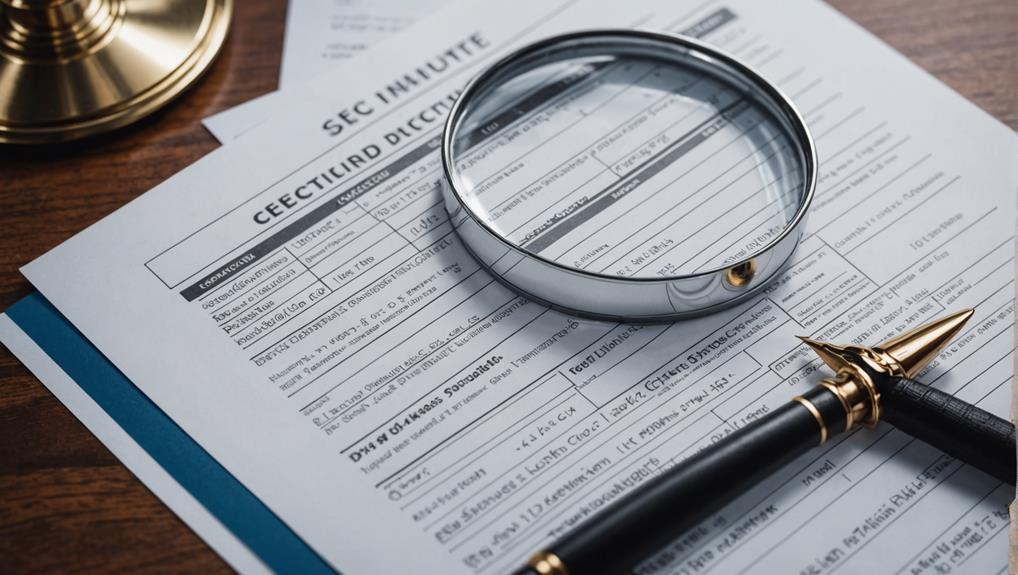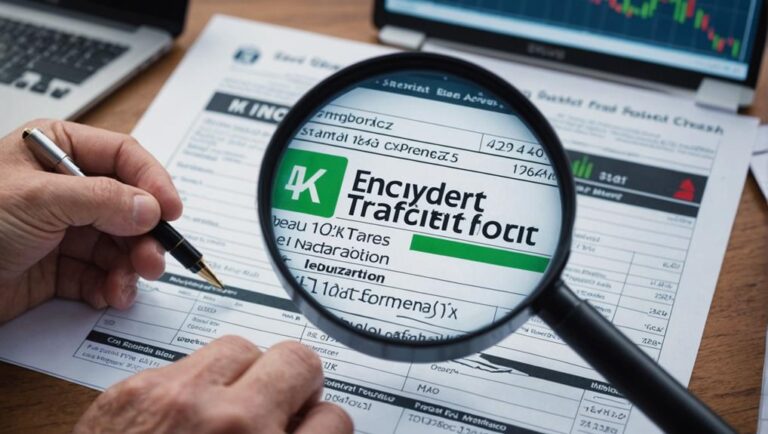Compliance With Federal Securities Laws: the Role of SEC Form 4

Adhering to federal securities laws necessitates the use of SEC Form 4, a crucial tool in the financial world. This form requires insiders, such as company officers and directors, to report any changes in their ownership of the company's securities promptly—within two business days. This mandatory disclosure plays a vital role in maintaining transparency in the market and holding insiders accountable for their actions, thereby preventing the misuse of confidential information. Failure to comply with Form 4 requirements can lead to significant penalties, negatively impacting both the company's reputation and investor confidence.
SEC Form 4 serves as a mechanism for ensuring fairness in the marketplace by providing essential details about the type of security involved in the transaction and the price at which the transaction occurred. This level of transparency is essential for safeguarding the interests of investors and upholding the integrity of the financial system.
By facilitating the disclosure of insider transactions, Form 4 contributes to the overall regulatory framework that governs securities trading and promotes a level playing field for all market participants. Understanding the significance of Form 4 in compliance with federal securities regulations is essential for navigating the complexities of the financial industry.
Key Takeaways
SEC Form 4 mandates the immediate disclosure of insider transactions to ensure transparency in the market and protect investors. Filing Form 4 accurately within two business days is crucial to avoid fines and uphold corporate integrity. Insiders are required to report any changes in beneficial ownership, which helps maintain fairness in the market and ensures compliance with regulations.
Failure to comply with Form 4 requirements can lead to severe penalties, lawsuits, and significant damage to a company's reputation. Therefore, accurate and timely filings of Form 4 are essential to prevent fraud and build trust among investors, ultimately supporting a level playing field in the marketplace.
Importance of Federal Securities Laws
Why are federal securities laws so vital for our financial markets? These laws are the foundation that keeps our financial system running smoothly, ensuring that investors are safeguarded against fraud and that markets operate with openness and equity. Compliance with these regulations is crucial, particularly concerning insider transactions.
Insider transactions, if not disclosed properly, can result in significant market abuse and diminish public confidence. This is where Form 4 plays a crucial role. Form 4 is a vital tool for upholding transparency, compelling insiders to report any alterations in their ownership of a company's securities.
By requiring prompt disclosure, Form 4 helps prevent the exploitation of internal information, which could otherwise create unfair advantages and manipulate the market. Adhering to federal securities laws, including the accurate filing of Form 4, ensures that all parties abide by the same standards, promoting a level playing field.
Non-compliance can lead to stringent enforcement measures by the SEC, underscoring the significance of these regulations. When we all commit to compliance, we contribute to a more resilient, just, and innovative financial market, setting the stage for future progress and trust.
Overview of SEC Form 4
SEC Form 4 is a crucial regulatory tool that mandates insiders to disclose their transactions in company securities promptly. This form plays a vital role in maintaining transparency and trust in the financial markets by ensuring that all stakeholders are informed about significant insider transactions.
Insiders, such as officers, directors, and beneficial owners holding over 10% of a company's securities, must file Form 4. This form captures essential information like the type of security involved, the number of shares, the price per share, the nature of the transaction, the transaction date, and the post-transaction ownership.
By requiring these disclosures, the SEC aims to prevent illegal activities like insider trading, as Form 4 provides a clear record of how insiders interact with their company's securities. Failure to comply with Form 4 regulations can result in severe consequences, including civil or criminal actions.
In today's dynamic financial landscape, adherence to Form 4 regulations isn't just about compliance; it's about promoting a culture of innovation and integrity. By understanding and following these requirements, we contribute to a fair and transparent marketplace, benefiting all stakeholders involved.
Beneficial Ownership Explained

Beneficial ownership refers to individuals who truly benefit from owning securities, even if those securities are held under a different name. These owners have legal responsibilities, such as voting rights and the ability to receive dividends. Understanding these details is crucial for meeting reporting thresholds and staying compliant with SEC Form 4 requirements.
SEC Form 4 is a regulatory filing that insiders of a company must submit to the Securities and Exchange Commission (SEC) to disclose any changes in their ownership of company stock. Insiders, such as directors, officers, and shareholders with more than 10% ownership, are required to report their transactions, including purchases, sales, and grants of stock options.
Failure to comply with SEC Form 4 requirements can result in penalties and legal consequences for insiders. By accurately reporting changes in ownership, insiders provide transparency to investors and regulators, ensuring that all relevant information is disclosed in a timely manner. It's essential for insiders to follow these regulations to maintain the integrity and fairness of the financial markets.
Defining Beneficial Ownership
Beneficial ownership refers to the true underlying ownership of securities, even if they aren't directly registered in one's name. This concept is crucial in the realm of securities as it determines who enjoys the economic benefits and holds the voting power associated with those securities.
Understanding ownership, especially beneficial ownership, is vital for insiders to adhere to SEC regulations and accurately report any changes.
Beneficial ownership can take various forms, including indirect holdings through entities like trusts or family members, economic interests entailing the right to receive income from securities, voting rights enabling influence over company decisions, and control or influence in the management or policies of the issuing entity.
Recognizing these facets underscores the significance of beneficial ownership in fostering transparency and accountability in the market. Defining and reporting beneficial ownership correctly upholds the financial system's integrity, nurturing trust among investors and regulators alike.
This is where SEC Form 4 comes into play, mandating insiders to disclose any alterations in their beneficial ownership. This requirement serves to enhance compliance and transparency within the financial landscape.
Legal Obligations Overview
Insiders must comply with a complex array of legal obligations to ensure that their transactions in company securities are transparent and in line with federal regulations. At the core of this compliance is SEC Form 4, a crucial tool for reporting insider transactions.
Whenever insiders engage in transactions involving company securities, they're required to submit Form 4 within two business days. This prompt reporting ensures that both the public and regulators have immediate access to information about these transactions.
Each transaction is precisely categorized to denote its nature—whether it involves common stock or derivative securities—providing clarity on the type of beneficial ownership change. This transparency plays a vital role in upholding market integrity and nurturing investor confidence.
The significance of adhering to these reporting obligations can't be overstated; failure to file Form 4 on time can result in enforcement actions by the SEC and substantial penalties.
Reporting Thresholds Importance
Understanding reporting thresholds is crucial for transparency and preventing insider trading. When we mention reporting thresholds, we're talking about the specific criteria that trigger the requirement for insiders to disclose their ownership of a company's securities.
For instance, insiders are obligated to submit a Form 3 if they possess more than 10% of a company's stock. Transactions that surpass $10,000 necessitate a Form 4, whereas unreported transactions are addressed through Form 5.
Meeting these thresholds isn't just a procedural step; it's vital for upholding market integrity. Non-compliance can lead to SEC enforcement actions, which may involve significant penalties and harm to reputations.
Insiders must adhere to Form 4 requirements when reporting changes in their ownership of company stock. This form plays a critical role in ensuring transparency and accountability in the financial markets.
By promptly disclosing significant transactions, insiders contribute to maintaining trust and integrity within the investment community.
In the realm of securities regulation, Form 4 serves as a key tool for monitoring insider activities and preventing illicit practices such as insider trading. Its strict reporting thresholds help to safeguard against potential abuses of privileged information, ultimately fostering a fair and level playing field for all investors.
Key Stakeholders
Key stakeholders in SEC Form 4 filings, such as officers, directors, and individuals holding more than 10% of a company's securities, are mandated to promptly disclose their insider transactions to ensure compliance and transparency. These disclosures aren't mere regulatory formalities; they're crucial for upholding the integrity of the market.
Officers and directors, as key decision-makers within a company, wield significant influence over investor trust and market perceptions. When these leaders report their transactions, it conveys a strong message of accountability and openness.
Beneficial owners, who possess substantial shares, also play a vital role in this framework. Their disclosures can indicate market trends and potential changes in company control. By adhering to Form 4 requirements, these stakeholders contribute to maintaining fair and equitable conditions for all investors.
Compliance isn't a choice; it's a foundation of trust in the securities industry. Timely and precise Form 4 filings offer invaluable information to investors and regulators, aiding in the identification and prevention of potential insider trading activities.
Let's utilize this transparency to nurture innovation and confidence in the financial markets, ensuring we uphold the highest standards of legal and ethical behavior.
Reporting Requirements

Insiders are mandated to file Form 4 promptly, within two business days of conducting transactions involving company securities. This regulatory requirement ensures timely disclosure of insider activities, promoting transparency and upholding market integrity.
Form 4 plays a crucial role in reporting insider transactions, covering common stock and derivative securities. Each transaction is coded to provide clarity on its nature and purpose, aiding stakeholders in interpreting the information efficiently.
Adherence to the two-business-day filing deadline is crucial to comply with reporting regulations. Accuracy in coding and reporting each transaction is paramount to reflect the true essence of insider dealings. Public availability of these filings enhances market transparency, empowering investors to make well-informed decisions.
Non-compliance with these reporting obligations can result in severe consequences, including legal actions and penalties. It's essential for insiders to understand and follow these requirements diligently to maintain fairness and protect investor interests.
Timeline for Filing
Filing Form 4 requires strict adherence to a two-business-day deadline following any insider transaction to ensure compliance with federal securities laws.
Failure to meet this deadline can result in significant consequences, including civil fines and potential criminal charges.
Timely filing is crucial not only to avoid penalties but also to uphold transparency and trust in the market.
Filing Deadline Requirements
Meeting the SEC's stringent two-day deadline for filing Form 4 is crucial to ensure compliance and avoid potential legal consequences. This firm filing deadline requirement is a fundamental aspect of federal securities laws, established to promote transparency and accountability among insiders.
The SEC mandates that Form 4, which discloses changes in beneficial ownership, must be submitted within two business days of an insider transaction. Failure to meet this deadline can lead to civil or criminal actions, highlighting the critical importance of timely submission.
To adhere to the filing deadline requirements, a meticulous approach is essential. This includes:
- Continuous Monitoring: Vigilantly track all transactions to prevent any oversights.
- Automated Notifications: Utilize technology to set up alerts that remind insiders of impending deadlines.
- Dedicated Compliance Teams: Assign specific individuals or teams to oversee and manage the filing process effectively.
- Ongoing Training: Ensure all relevant staff members are well-informed about the regulations and procedures for filing Form 4.
In today's fast-paced and evolving landscape, implementing these strategies is key to maintaining strict compliance with the SEC's regulations. By doing so, we not only adhere to federal securities laws but also uphold the integrity and transparency that investors and the market expect.
Reporting Period Window
The strict two-business day window for submitting Form 4 highlights the critical need for prompt reporting of insider transactions. According to the Securities Exchange Act, the timeframe for filing Form 4 is stringent to ensure that significant transactions are disclosed promptly. This requirement is essential for maintaining the integrity of the market and fostering trust among investors. It's crucial for individuals involved in insider trading to comply with this tight reporting period.
The mandated two-business day filing period under the Securities Exchange Act is designed to promote real-time transparency. This quick turnaround enables investors to make well-informed decisions based on the most up-to-date information available. As we navigate the complexities of federal securities laws, it becomes clear that timely submission of Form 4 is imperative for compliance.
Furthermore, the two-business day rule isn't merely a suggestion; it's a legal obligation with significant consequences for non-compliance. Missing the filing deadline can result in severe penalties, underscoring the urgency of immediate action. It's essential to ensure that all relevant parties are adequately prepared to report any material transaction within this narrow timeframe. Taking a proactive approach not only promotes compliance but also enhances overall market efficiency and fairness.
Late Filing Consequences
Failing to submit SEC Form 4 within the necessary two-business day timeframe can result in significant consequences, highlighting the critical nature of timely disclosure. Adhering strictly to federal securities laws requires meeting this deadline promptly. Timely filing not only promotes transparency but also shields us from the negative outcomes associated with late submissions that could harm our credibility and financial stability.
Missing the filing deadline can lead to various penalties:
- Legal repercussions: The SEC may take legal action, imposing fines or even incarceration in severe instances.
- Investor trust: Delayed filings may undermine trust, as stakeholders anticipate timely and accurate disclosures.
- Damage to reputation: Consistent delays in filing could suggest issues with operations or governance, impacting our public image.
- Financial sanctions: Late submissions may result in monetary penalties, affecting our financial well-being and overall performance.
It is clear that timely disclosure through SEC Form 4 isn't just a regulatory obligation but a crucial element in upholding our corporate integrity and investor relations. By meeting the two-day filing deadline, we ensure compliance with federal securities laws and safeguard our organization's reputation and financial standing.
Let's prioritize this vital aspect of our reporting responsibilities, recognizing its significant impact on our credibility and success.
Detailed Form 4 Instructions

To ensure compliance, it's crucial to meticulously follow the detailed instructions provided for reporting insider transactions on Form 4. This form is essential for disclosing insider transactions, promoting transparency and trust in the securities market. The instructions outline the reporting persons, their relationship to the company, transaction specifics, and the securities involved.
Filing Form 4 within two business days of any significant insider transaction is a strict requirement, emphasizing the need for real-time transparency. Electronic filing through EDGAR isn't just recommended; it's a streamlined process that facilitates meeting these essential filing deadlines promptly and efficiently.
Accuracy is paramount for every section of Form 4. Reporting individuals must clearly indicate their association with the company, whether as officers, directors, or beneficial owners of over ten percent of a class of equity securities. Transaction details should include the transaction type, date, and the number of shares involved.
Failure to disclose transactions correctly can result in severe civil or criminal consequences. By adhering to these detailed instructions, we ensure compliance and maintain the integrity of our financial markets.
Common Mistakes
When dealing with SEC Form 4 compliance for disclosing changes in ownership of company stock by insiders, it's common to encounter mistakes like inaccurate reporting dates, omitted transaction codes, or incomplete beneficial ownership details.
These errors can have serious implications, including legal and financial consequences. Therefore, it's crucial to pay close attention to these specifics to ensure full compliance and prevent any potential issues.
Incorrect Reporting Dates
One common error in complying with SEC Form 4 requirements is inaccurately reporting transaction dates. Reporting dates are crucial under SEC regulations, and any mistakes can lead to serious compliance issues. Inaccurate reporting of transaction dates can result in violations of SEC regulations, potentially leading to penalties or enforcement actions.
To ensure compliance, it's important to be aware of the following common pitfalls:
- Missing the deadline of two business days: Transactions must be reported within two business days to avoid regulatory scrutiny.
- Providing an incorrect transaction date: The transaction date should accurately reflect the actual date of the transaction, not when it was recorded.
- Misinterpreting time zones: Verify that the date reflects the correct time zone to prevent discrepancies.
- Errors in manual data entry: Simple mistakes like typos or misentries can lead to incorrect reporting dates, putting compliance at risk.
Adhering to these guidelines is essential for maintaining compliance with SEC regulations. Timely and accurate reporting of transaction dates isn't just a procedural requirement; it's a critical aspect of regulatory compliance.
Missing Transaction Codes
The absence of transaction codes in SEC Form 4 filings often results in significant reporting errors regarding insider transactions. These codes play a crucial role in indicating the nature of insider activities, whether it involves a purchase, sale, or option exercise. When transaction codes are omitted, it doesn't just lead to minor oversights; it results in incomplete disclosure to the SEC. This lack of information can obscure the true extent of insider transactions, undermining the transparency that Form 4 is intended to provide.
Each transaction documented on Form 4 must be accurately coded to ensure clarity and compliance with SEC regulations. The correct utilization of transaction codes isn't merely a procedural requirement—it is fundamental to reliable financial reporting. By carefully assigning codes to each transaction, we contribute to a transparent and effective market environment, thereby enhancing investor trust and regulatory adherence.
In a time where market dynamics are heavily influenced by innovation, the accurate reporting of insider transactions is imperative. Let's acknowledge the duty that comes with completing Form 4 accurately. By doing so, we uphold the integrity of financial markets and promote a culture of openness and responsibility.
Incomplete Beneficial Ownership
Incomplete beneficial ownership filings often result from common errors that can significantly impact the accuracy of SEC Form 4 submissions. It's crucial to address these pitfalls to ensure compliance and uphold the integrity of our reporting.
Filing Form 4 on time is crucial, as missing reporting deadlines can lead to incomplete beneficial ownership filings. Timeliness is key to meeting regulatory requirements.
Accurate reporting of transaction details is essential. Precise information regarding transaction dates, amounts, and involved parties is necessary to avoid errors that could compromise the entire filing's accuracy.
Disclosing all relevant ownership changes, no matter how small, is vital. Failure to report every change in ownership can result in incomplete reporting and potential legal consequences.
Providing all required information on insider transactions is imperative. Every insider transaction must be fully disclosed to prevent omissions that could render a Form 4 submission incomplete and non-compliant.
Consequences of Non-Compliance

When companies fail to comply with SEC Form 4 filing requirements, the consequences can be severe and wide-ranging. Non-compliance with SEC Form 4 can lead to civil and criminal actions. The SEC takes these violations seriously, and not disclosing insider transactions promptly can result in heavy penalties and strict enforcement measures.
Immediate fines are a common consequence of non-compliance, but the repercussions don't end there. Legal actions such as lawsuits and even potential criminal charges can quickly follow for more serious violations. Additionally, the company's reputation can suffer a significant blow.
In today's fast-paced, innovation-focused market, trust and transparency are crucial, and any violation can undermine investor confidence.
Submitting Form 4 in a timely manner is crucial to avoid these regulatory sanctions and to uphold transparency in insider trading activities. Adhering to SEC Form 4 requirements isn't only a legal duty but also essential for protecting investors' interests and maintaining market integrity.
Failure to comply not only risks the company's relationship with regulatory authorities but also its ability to build trust and drive innovation among stakeholders. Let's ensure we always comply with federal securities laws.
Insider Trading Prevention
Preventing insider trading is crucial for ensuring fair and transparent financial markets. The mandatory utilization of SEC Form 4 is a key measure in achieving this goal. This form ensures that insider transactions are promptly disclosed, thereby preventing the misuse of important, non-public information. Timely submission of Form 4 is vital as it immediately informs the market about the trading activities of company insiders.
Form 4 serves various essential purposes in preventing insider trading, including:
- Transparency: Insiders are required to report their trades within two business days, ensuring swift disclosure to the market.
- Accountability: By documenting insider transactions, Form 4 holds insiders responsible for their trading actions.
- Deterrence: The necessity of filing Form 4 acts as a deterrent against inappropriate trading behavior, as non-compliance may lead to SEC enforcement actions.
- Market Integrity: The prompt disclosure mandated by Form 4 helps uphold the integrity and fairness of financial markets.
Embracing tools like Form 4 is crucial for promoting market integrity in the face of innovation. SEC enforcement actions play a significant role in ensuring compliance with these filings, underscoring their importance. Ultimately, Form 4 plays a critical role in fostering a transparent and equitable financial environment, essential for bolstering investor confidence and enhancing market efficiency.
Comparing Form 3 and Form 5

When comparing SEC Form 3 and SEC Form 5, we notice clear distinctions in their roles and deadlines concerning the disclosure of insider trading activities.
SEC Form 3 is the initial disclosure form mandated when an individual becomes an insider of a company, like an officer, director, or a beneficial owner of over 10% of a company's stock. This form must be submitted within 10 days of obtaining insider status, ensuring prompt transparency.
In contrast, SEC Form 5 functions as a year-end comprehensive report, due within 45 days after the company's fiscal year concludes. It covers any transactions not previously disclosed on SEC Form 4, including those that may have been exempted or inadvertently overlooked. This process guarantees that all insider transactions are eventually reported, promoting thorough compliance with federal securities laws.
Both forms employ identical transaction codes to specify the nature of the transactions reported, simplifying the process and aiding regulators and the public in understanding the disclosed information.
Real-World Examples
Elon Musk's Form 4 filings for Tesla Inc. exemplify the importance of SEC Form 4 in maintaining market transparency. These filings provide detailed information on Musk's insider trades, such as the transaction date, security type, and share prices. Filing the Form 4 promptly, within two business days, ensures that the public is quickly informed about significant changes in insider holdings.
In Musk's Form 4 filings:
- The reporting person is clearly identified as Musk, ensuring accountability.
- Transaction details are listed, coded for transparency.
- Security type and shares are specified, indicating the type and quantity of securities involved.
- Ownership tracking facilitates monitoring changes in Musk's holdings over time.
These aspects showcase how Form 4 filings contribute to a transparent market. Investors can gain valuable insights into insider trades, which may provide signals about company prospects.
As financial markets evolve, the role of SEC Form 4 remains essential in ensuring transparent and well-informed investing decisions.
Additional Resources

For those keen on delving deeper into insider transactions, several third-party websites offer comprehensive information and tools for further exploration. Utilizing these resources can significantly enhance our comprehension of compliance and insider reporting. Search engines can help locate websites that provide detailed insider reports, including SEC Form 4 filings.
These websites typically feature real-time alerts, historical data, and analytical tools, allowing us to effectively monitor insider ownership and transaction trends. This can be especially beneficial for individuals seeking to revamp their investment strategies.
Moreover, the SEC's Office of Investor Education and Advocacy website serves as a crucial resource. It offers educational materials that delve into the nuances of insider reporting, particularly under Section 16 of the Exchange Act.
To have a handy reference, blank PDF versions of Forms 3, 4, and 5 are easily accessible online. These forms are essential for grasping the reporting requirements and ensuring compliance.
Frequently Asked Questions
What Is the Purpose of SEC Form 4?
SEC Form 4 is filed to ensure transparency and prevent insider trading by disclosing changes in ownership of company stock by insiders. By adhering to the two-business-day filing deadline, we promote trust and integrity in the financial markets, fostering an environment conducive to innovation and ethical practices.
What Is Required on the SEC Form S-4?
SEC Form S-4 is a crucial document utilized in about 90% of mergers. The filing deadlines associated with this form ensure that disclosures are made in a timely manner. This form imposes reporting obligations that include details on the terms of the transaction, information on beneficial ownership, financial data, and voting rights. These requirements are essential for enabling shareholders to make well-informed decisions regarding the merger.
One key aspect of SEC Form S-4 is the disclosure of changes in ownership of company stock by insiders. This information is vital for maintaining transparency and ensuring that investors have a clear understanding of any significant shifts in ownership within the company. By providing this data, the form helps to protect the interests of shareholders and promote accountability within the organization.
What Is the SEC Form F4?
Understanding SEC Form 4 is essential for meeting reporting obligations related to insider trades. This form ensures that any changes in ownership of company stock by insiders are disclosed within specific deadlines, fostering transparency and accountability in the market. By staying compliant with SEC Form 4 requirements, we can uphold integrity and confidence in our trading practices. Let's prioritize staying informed and following the necessary procedures to maintain trust and transparency in our transactions.
What Does SEC Form 4 Transaction Code a Mean?
Transaction Code A on SEC Form 4 indicates that insiders have disclosed the details of their acquisition of equity securities. Monitoring these transactions is crucial for understanding insider trading activities and ensuring transparency in the financial markets. By fulfilling their reporting obligations, insiders provide valuable information that can assist investors in making informed decisions.
Conclusion
In compliance with federal securities laws, SEC Form 4 plays a crucial role in upholding market transparency and integrity. For instance, when Elon Musk acquired more Tesla shares, he promptly filed SEC Form 4, showcasing adherence to reporting requirements.
By comprehending and adhering to these regulations, we can deter insider trading and safeguard investor interests. Our grasp of beneficial ownership and timely reporting fosters trust in the financial markets, underscoring the significance of these legal frameworks.






